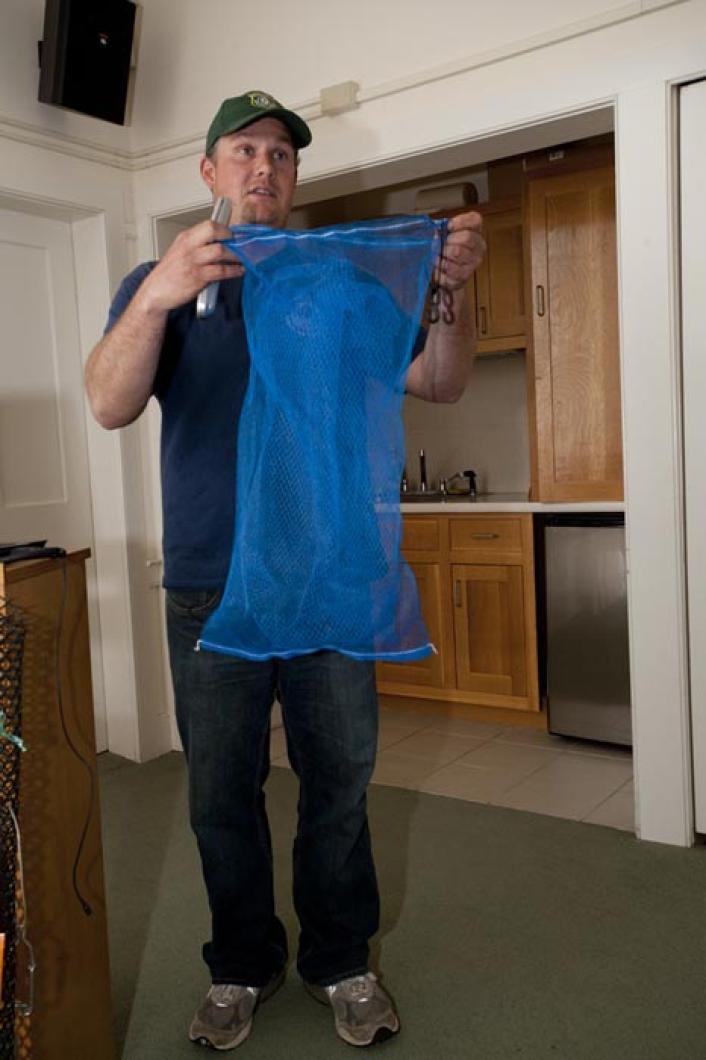Isaiah Scheffer is hopeful about the future for those who love to go bay scalloping, oystering and quahaugging in Chilmark. Recent successes in all three fisheries may be due to Mother Nature, but another key ingredient is some labor-intensive, progressive shellfish restoration work. Mr. Scheffer recently gave a talk and slideshow at the Chilmark Free Public Library about that ongoing work.
Mr. Scheffer outlined the different ways he has been able to restock the ponds with shellfish since he was hired by the town to do shellfish restoration and two years ago became shellfish constable. He has been out raising juvenile shellfish in the ponds, using proven techniques that go back over 30 years on the Vineyard.
Mr. Scheffer starts putting out the quahaugs in the spring, bay scallops and oysters in the summer.
“The ponds are dynamic and we are trying hard to stay on top of it,” he said. “Ninety-five per cent of my job is growing seed.” A smaller part of his job is monitoring what the shellfishermen harvest. There is also enforcement.
With the help of the Martha’s Vineyard Shellfish Group, Mr. Scheffer said last year he was able to obtain and raise a million quahaug seed, 125,000 oyster seed and 1.8 million bay scallops. But this is not about just planting seed out in the ponds, so that when they grow the fishermen have something to harvest. Mr. Scheffer said the goal is to make sure there are adult shellfish in the pond so that they spawn. Communities and towns have gotten into trouble when the native shellfish in residence get so low that there are no new juveniles coming along.
It takes a bay scallop 18 months to get from the larval stage to adult harvestable size. All it takes is one really bad year to decimate the fishery.
“It only takes a few adult bay scallops to repopulate a pond,” Mr. Scheffer said. “I am trying to make sure that there are enough adult bay scallops out there so that when they spawn, there are more coming along,” he said. The work he did two and three years ago to promote bay scallops helped the fishermen this past winter.
In a season that ran from October through March, Mr. Scheffer said, Chilmark shellfishermen harvested about 2,000 bushels of bay scallops. He added that 30 commercial fishermen harvested 1,705 bushels of the bay scallops, and at market rates they earned $281,325 just for the sale of the meat.
Mr. Scheffer then showed how he takes thousands of juvenile bay scallops, microscopic in size, that he gets from the shellfish hatchery and puts them in safe cages. He spoke of moving the shellfish each time they are large enough from one larger mesh bag to the next. They begin in spat bags, a bag that looks like a 50 pound bag of onions. The scallops are almost microscopic. The bag protects the shellfish from harmful predators. And since the bags hang from the surface, out of view, the animals are treated to the best food. Shellfish are filter feeders and providing them with plenty of food assures fast growth.
Mr. Scheffer said from day to day he can see the animals grow. “When there is less competition for food, they really grow. They love it.”
The oyster fishery in Tisbury Great Pond last summer got a huge boost. Mr. Scheffer outlined a number of efforts that he is involved in to help the oyster fishery. Last July he discovered that the oyster set in the pond far outweighed anything he had ever seen and many more before him. Millions, perhaps billions, of baby oysters had settled on the pond’s rocks, shellfish, culch and bottom.
While it is likely that a lot of those juvenile oysters did not survive because of overcrowding, the message is that the huge numbers of oysters point to a far more positive future than a difficult recent past.
Mr. Scheffer talked about a shellfish disease called Dermo that caused the oyster fishery to collapse years ago. And fortunately, through the efforts of others, a newer more disease resistant oyster is growing in the pond. While those animals won’t be harvestable for another two to three years, the future looks promising for oysters returning to the pond.
The quahaug fishery is doing well. Mr. Scheffer spoke about raising 645,000 baby quahaugs in a floating raft the size of a sheet of plywood, four by eight feet. “Last year we had eight rafts. We’ll do 12 rafts this year,” Mr. Scheffer said. Each raft lies just below the surface, kept off the bottom by floats.
Martha’s Vineyard Shellfish Group director Rick Karney sat in the back of the library meeting room and listened to the program. “He is so professional,” Mr. Karney said of Mr. Scheffer after the talk. “It is a pleasure working with him. As you can see, they work like dogs. The work he does with his assistant is intensive.
“You have to be passionate to do something like that. And you know, it shows.”




Comments
Comment policy »